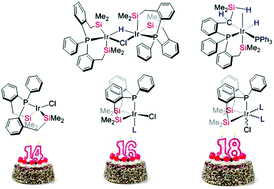Iridium complexes featuring a tridentate SiPSi ligand: from dimeric to monomeric 14, 16 or 18-electron species†‡
Abstract
In the solid state, the dinuclear iridium complex [μ-Cl-Ir(SiMe2CH2-o-C6H4)2PPh]2, 1, is shown by X-ray diffraction to bear dibenzylsilylphosphine ligands in SiPSi tridentate coordination modes as well as chloride bridges. In C6D6 solution, 1 dissociates into the 14-electron species [IrCl(SiMe2CH2-o-C6H4)2PPh] prone to coordinate one or two L-type ligands such as PR3 (R = Cy, Ph, OEt), CO and CH3CN giving rise to the corresponding mononuclear 16- or 18-electron complexes [IrCl(SiMe2CH2-o-C6H4)2PPh(L)x] (x = 1, 2) as evidenced by X-ray and NMR studies. The dinuclear structure is retained upon reaction with Et3SiH which results in the formation of [μ-Cl,μ-H-Ir2{(SiMe2CH2-o-C6H4)2PPh}2] with a bridging hydride. On the basis of NMR studies, the reaction of the triphenylphosphine complex [IrCl(SiMe2CH2-o-C6H4)2PPh(PPh3)] with LiBHEt3 leads to the hydride complex [IrH(SiMe2CH2-o-C6H4)(η2-H-SiMe2CH-o-C6H4)PPh(PPh3)] in which one SiPSi ligand has been transformed and is now bonded to iridium in a tetradentate mode via P, Si, an agostic Si–H bond, and C of a methine as a result of the activation of one methylene group.

- This article is part of the themed collections: Celebrating recent chemical science in Mexico and Breaking bonds over many timescales: in celebration of Robin Perutz’s 70th birthday


 Please wait while we load your content...
Please wait while we load your content...